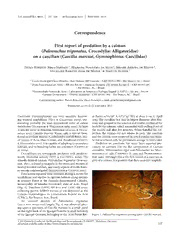
First report of predation by a caiman (Paleosuchus trigonatus, Crocodylia: Alligatoridae) on a caecilian (Caecilia marcusi, Gymnophiona: Caecilidae) PDF
Preview First report of predation by a caiman (Paleosuchus trigonatus, Crocodylia: Alligatoridae) on a caecilian (Caecilia marcusi, Gymnophiona: Caecilidae)
SALAMANDRA 49(4) 227–228 30 December 2013CorreISspSNon 0d0e3n6c–e3375 Correspondence First report of predation by a caiman (Paleosuchus trigonatus, Crocodylia: Alligatoridae) on a caecilian (Caecilia marcusi, Gymnophiona: Caecilidae) Paulo Roberto Melo Sampaio 1, Mariana Nogueira da Silva 2, Simone Arruda de Matos 2, Lucicleia Railene Assis de Matos 2 & Martin Acosta 3 1) Escola Municipal Chico Mendes – Rua Shalom, 468 Corrente – CEP. 69.914-990 – Rio Branco, AC – Brazil 2) União Educacional do Norte – BR 364 Km 02 – Alameda Hungria, 200 Jardim Europa II – CEP. 69.915-497 – Rio Branco, AC – Brazil 3) Universidade Federal do Acre – Laboratório de Botânica e Ecologia Vegetal (LABEV) – BR-364 – km 04 – Campus Universitário – Distrito Industrial – CEP. 69.915-900 – Rio Branco, AC – Brazil Corresponding author: Paulo Roberto Melo Sampaio, e-mail: [email protected] Manuscript received: 22 September 2013 Caecilians (Gymnophiona) are very secretive burrow- er Basin; 10°04’56’’ S, 67°37’33’’ W), at 18:00 h on 27 April ing tropical amphibians (Vitt & Caldwell 2009), rep- 2013. The caecilian (6.8 mm in largest diameter after fixa- resenting probably the least understood order of extant tion) was grasped in the anterior and medial portion of the vertebrates (Nussbaum & Wilkinson 1989, 1995). At least body by the caiman, which succeeded with pulling it out of 15 species occur in Brazilian Amazonia (Maciel & Hoog- the muddy soil after few minutes. When handled for col- moed 2011). Caecilia marcusi Wake, 1985 is one of these, lection, the caiman did not release its prey. The caecilian found in lowland Bolivia (Cochabamba and El Beni), Bra- and the caiman were preserved in 10% formalin and trans- zil (states of Acre, Mato Grosso, and Rondônia) (Maciel ferred to ethanol 70% for permanent storage 72 hours later. & Hoogmoed 2011). It is capable of adapting to secondary Predation on caecilians has never been reported pre- habitats, and its breeding habits are unknown (Cortez et viously for caimans (for the diet composition of Caiman al. 2004). crocodilus, Melanosuchus niger and Paleosuchus see Mag- Crocodilians are semiaquatic predators with predomi- nusson et al. 1987, Campbell Jr. 1993 and Thorbjarnar- nantly nocturnal activity (Vitt & Caldwell 2009). The son 1993). Although this is the first record of a caecilian as smooth-fronted caiman, Paleosuchus trigonatus (Schnei- prey of a caiman, it is possible that these secretive amphibi- der, 1801), is found principally in the rivers and streams of heavily forested habitats, and many aspects of its life histo- ry remain uninvestigated (Magnusson & Campos 2010). Data herein reported were obtained during a survey for amphibians and reptiles in riparian habitats along streams in primary forest at the Fazenda Experimental Catuaba, municipality of Senador Guiomard, state of Acre, Brazil (Fig. 2). Vouchers (UFAC-RB 6112 and UFAC-RB 0100; collecting permit SISBIO #27290-3) are deposited at the Coleção Herpetológica da Universidade Federal do Acre (UFAC), Rio Branco, Acre, Brazil. An unsexed juvenile of Paleosuchus trigonatus (250.0 mm snout–vent length; Fig. 1) was observed prey- ing upon a specimen of Caecilia marcusi in a small pond on the right bank of the Igarapé Floresta (a small tributary of the Igarapé Quinauá, belonging to the Acre-Purus Riv- Figure 1. Paleosuchus trigonatus preying upon Caecilia marcusi. © 2013 Deutsche Gesellschaft für Herpetologie und Terrarienkunde e.V. (DGHT), Mannheim, Germany All articles available online at http://www.salamandra-journal.com 227 Correspondence Figure 2. Map showing the location of the Fazenda Experimental Catuaba, municipality of Senador Guiomard, Acre, Brazil. ans account for a more important portion of the food spec- Nussbaum, R. A. & M. Wilkinson (1989): On the classification trum of the small forest caimans of the genus Paleo suchus. and phylogeny of Caecilians (Amphibia: Gymnophiona), a We are confident that more accurate studies on caiman critical review. – Herpetological Monographs, 3: 1–42. species could contribute to elucidation of this question. Nussbaum, R. A. & M. Wilkinson (1995): A new genus of lung- less tetrapod: a radically divergent caecilian (Amphibia: Gym- nophiona). – Proceedings of Royal Society of London, B, 261: Acknowledgements 331–335. Thorbjarnarson, J. B. (1993): Diet of the Spectacled Caiman We are grateful to Adriano O. Maciel for the identification of (Caiman crocodilus) in the central Venezuelan llanos. – Her- the caecilian. Diego J. Santana, Danté B. Fenolio and one petologica, 49: 108–117. anonymous reviewer provided useful comments on earlier ver- Vitt, L. J. & J. P. Caldwell (2009): Herpetology: an introductory sions of this manuscript. biology of amphibians and reptiles. – Third edition, Academic Press, New York, 720 pp. References Campbell Jr., K. E. (1993): Habitat notes on Paleosuchus trigona- tus (Schneider) in Peru. – Journal of Herpetology, 7: 318–320. Cortez, C., S. Reichle, I. De la Riva & M. Wilkinson (2004): Caecilia marcusi. – in: IUCN 2012. IUCN Red List of Threat- ened Species. Version 2012.2. <www.iucnredlist.org>. Ac- cessed on 03 June 2013. Maciel, A. O. & M. S. Hoogmoed (2011): Taxonomy and dis- tribution of caecilian amphibians (Gymnophiona) of Brazil- ian Amazonia, with a key to their identification. – Zootaxa, 2984: 1–53. Magnusson, W. E., E. V. Silva & A. P. Lima (1987): Diets of Ama- zonian crocodilians. – Journal of Herpetology, 21: 85–95. Magnusson, W. E. & Z. Campos (2010): Schneider’s Smooth- fronted Caiman Paleosuchus trigonatus. – pp. 43–45 in: Ma- no lis, S. C. & C. Stevenson (eds.): Crocodiles. Status Sur- vey and Conservation Action Plan. – Third Edition, Crocodile Specialist Group: Darwin. 228
